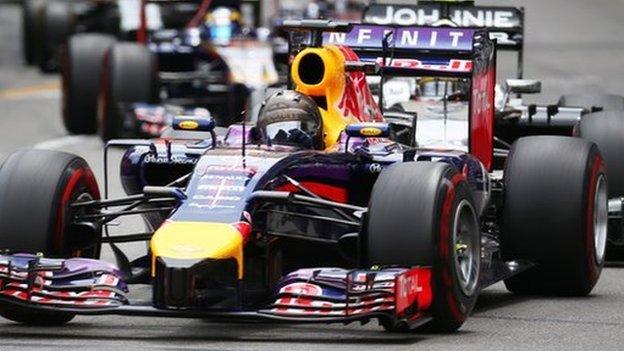Formula 1: Have McLaren-Honda found answer to engine problems?
- Published
- comments
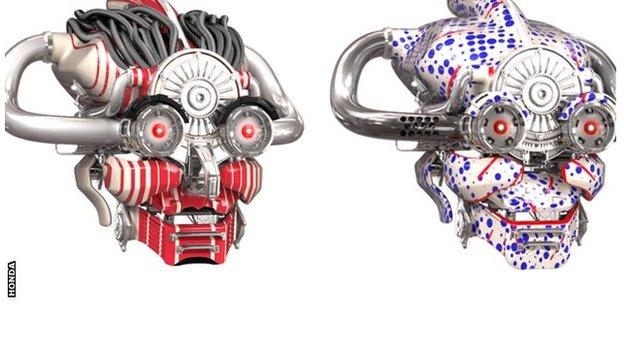
Honda have given the engines made for Jenson Button and Fernando Alonso personalities (and Twitter accounts) of their own
McLaren's engine partner Honda says it does not need a "miracle" to close its deficit to Mercedes by next season.
McLaren and Honda have been about 2.5 seconds a lap off the pace in 2015, the large part of the gap down to the engine.
Honda F1 boss Yasuhisa Arai said: "A car 2.5 seconds faster than us already exists, so in that sense it isn't a miracle. You can do it with the technology.
"McLaren and Honda must close the gap. That is the target, but it is hard work, considering the preparation time."
Can this be done?
McLaren driver Fernando Alonso said at the US Grand Prix 10 days ago that he felt it was "realistic" for the team to aim to win races in 2016. Their best results this year are a fifth place each for the Spaniard and his team-mate Jenson Button.
Alonso, who joined McLaren this season on a three-year contract with the ambition of winning a third world title, added at the Mexican GP last weekend that the team were "confident of being competitive next year."
The 34-year-old said: "We know there is no magic in F1", adding that a target of fighting for the championship was "very optimistic but we will try our best".
Arai, speaking in an exclusive interview with BBC Sport, said he believed Alonso's remarks were aimed at "trying to encourage the whole team and the (Honda engine) project".
Where is McLaren-Honda's deficit?
Honda is contributing a net $100m a year to McLaren's budget, as well as the money it spends on developing its engine, which will be at least that amount again.
But after starting the project late, and with less development time that its competitors, Honda's engine has lagged well behind its rivals during its debut season.
Honda is behind the standard-setting Mercedes power-unit both in terms of the power of the internal combustion engine (ICE) and, especially, the performance of the hybrid system.
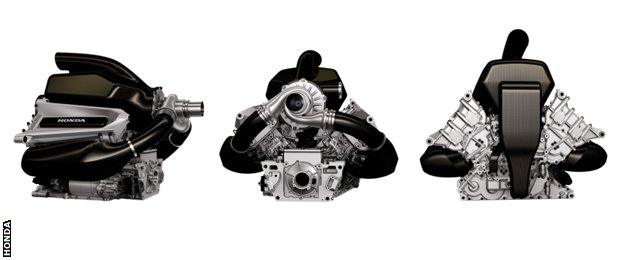
Honda's 1.6 litre V6 turbo hybrid engine is currently lagging well behind it's rivals on the Formula 1 grid
The ICE alone is believed to be in the region of 30bhp down on the Mercedes following an upgrade that was introduced at the US Grand Prix.
Far more significant is the shortfall in the hybrid system, which cannot harvest sufficient energy runs out of deployment well before the end of the longer straights.
In total, this means the Honda engine at its best is at least 80bhp down on Mercedes and at its worst, when the hybrid boost shuts down part-way along the straights, in the region of 250bhp down.
But Arai emphasised that not all the gain had to come from the engine, saying: "It is impossible to close a 2.5-second gap just with the power unit."
McLaren's car is not as competitive as the best chassis on the grid, the Mercedes and the Red Bull, but the Honda engine's lack of performance is believed to account for in the region of 80-90% of the lap-time gap to Mercedes.
Why is Honda so down on power?
The lack of performance of the Honda engine is rooted in a problem with the design of the turbocharger and the inter-linked part of the energy recovery system (Ers) called the MGU-H - the motor-generator unit-heat.
Honda's engine has a similar layout to that of the Mercedes, with the compressor situated forward of the turbine, and the MGU-H in between. The difference is that Honda's compressor sits within the vee of the six cylinders, rather than at the front of the engine like Mercedes'.
This means Honda's compressor is smaller than Mercedes' - the idea being to keep the engine compact to aid the car's aerodynamics.
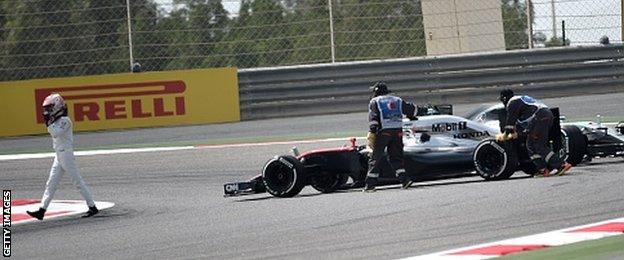
Jenson Button's car broke down in a practice session ahead of the Bahrain Grand Prix earlier this year
But the 2015 Honda engine's turbo-MGU-H system is inefficient - both in the amount of exhaust-gas energy it can pull in and the ability of the compressor to compress the air.
Although Honda understands what is wrong, it cannot make the necessary changes to the design this year because the restrictions on development within the rules did not give enough freedom to modify the fundamental architecture of the engine.
The engine's poor reliability has also been a factor.
"We definitely believe that because we had a lot of reliability issues that hindered us from focusing on power output, definitely next year should be a bit better," Arai says.
What can Honda do about it?
For next year, Honda does have enough leeway within the rules to make fundamental changes to the engine - and is planning to do so.
Arai says improving the efficiency of the turbo and compressor "is the first objective".
Honda aims to retain the current compact nature of the engine.
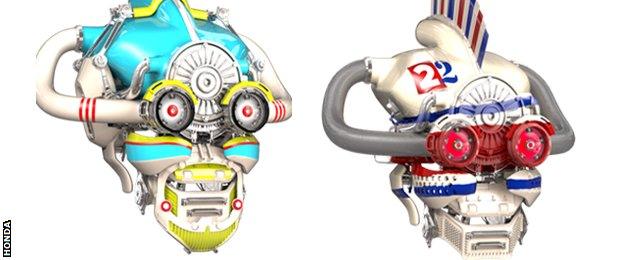
"At this moment, there is no plan to change the fundamental architecture because it affects the car," he says. "It will affect the aerodynamics greatly if we do change the architecture.
"McLaren and Honda agree that to make it a more aerodynamically efficient car they want to keep the package as small as possible."
But the compressor size will increase to aid this quest for efficiency - Arai predicts that the 2016 Honda compressor will be "probably about the same size more or less as Mercedes", while adding that he does not know in what ways Mercedes will change its design.
Why are the turbo and MGU-H so important?
The F1 turbo hybrid engines have two energy recovery elements, with motors attached to the rear axle (MGU-K) and the turbo (MGU-H).
The amount of kinetic energy that can be recovered and deployed from the rear axle through the MGU-K is limited by regulation. But the amount that can be used from the MGU-H is free, so it has a critical influence on the performance and efficiency of the overall power-unit.
F1's four engine manufacturers are split in their design approaches to this system.
Honda and Mercedes have the MGU-H situated between the compressor and turbine. Mercedes have placed the compressor in front of the cylinder block, whereas Honda's is within the vee of the cylinders.
Renault and Ferrari have the MGU-H at the front of the package, followed by the compressor and turbine. But in both cases they are at the back of the engine.
Mercedes currently has a small power advantage over Ferrari of about 10-15bhp. Renault is in the region of 60bhp behind Mercedes.
- Published8 November 2015

- Published1 November 2015

- Published8 November 2015

- Published18 December 2015
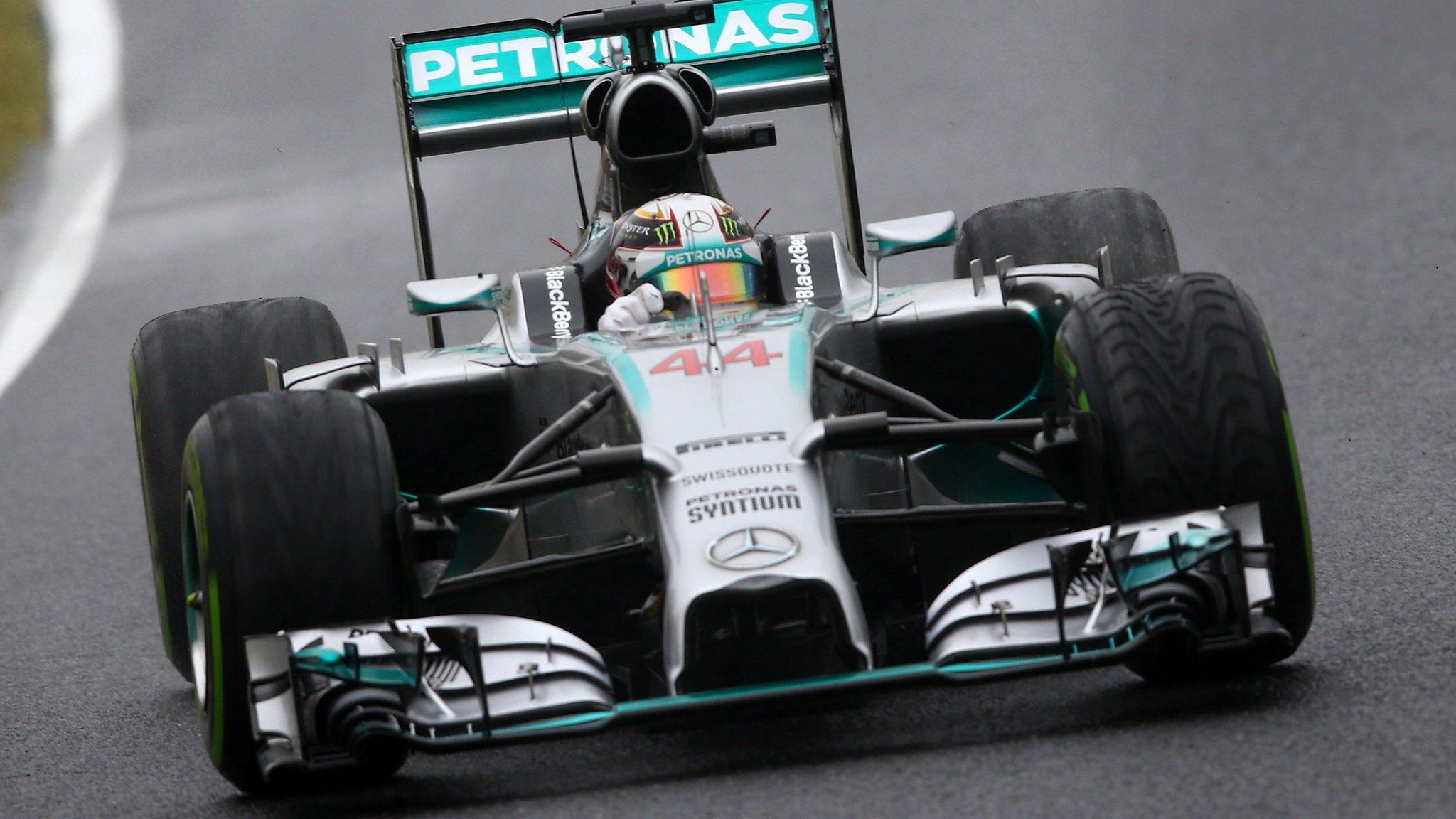
- Published2 November 2018

- Published26 February 2019
